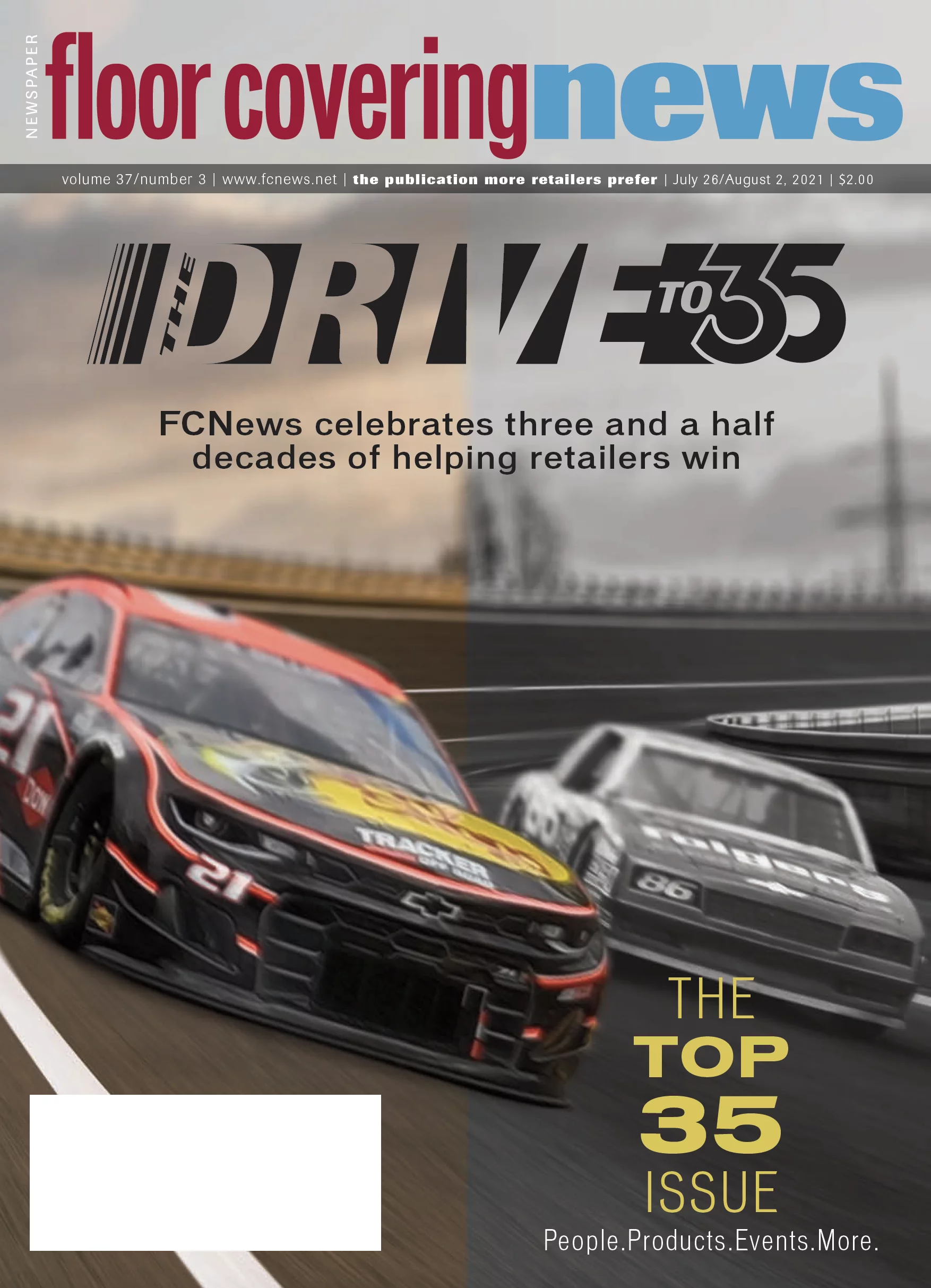All the right moves: Mohawk Industries chairman and CEO, Jeff Lorberbaum, shepherds company through the highs and lows
 What he witnessed in 1986…
What he witnessed in 1986…
“In the 1980s there were hundreds of small carpet mills scattered across northwest Georgia, and carpet and rugs comprised about 80% of the flooring sold in the U.S. At that time, most carpet manufacturers sold their products through distributors, so the relationship between the manufacturers and flooring retailers was largely indirect. Mohawk had introduced the industry’s first co-branding program earlier with ColorCenter, which created a marketing advantage for our retail partners.”
Q&A
What would you say was the first sea change post-1986?
A major difference from that era was the sales channels. There were more independent retailers and they’d reach customers through newspaper ads and mass mailings. Department stores and mass merchants were selling a lot of flooring at that time and helped to establish trends. The DIY chains hadn’t yet established a national presence. When Stainmaster was released, cleaning stains was a significant concern of all carpet purchasers. I have never seen a new product innovation adopted so quickly. In a very short time no one wanted carpet without stain resistance.
Shortly thereafter, the extrusion of olefin by the carpet manufacturers created a new value proposition and led to the evolution of residential berbers. Olefin transitioned from a niche alternative to almost 30% of the industry’s volume. We were able to make highly styled carpets that were durable and changed both the residential business as well as the Main Street carpet category.
The other sea change this started for the industry was the introduction of extrusion operations by carpet manufacturers. The carpet manufacturers who invested in fiber production created so much efficiency that it became a catalyst for further consolidation of the industry, and this eventually led to the exit of chemical companies as major fiber suppliers to the industry.
How was the industry different in the mid-1990s, when you took the reins, versus 1986?
By the mid-1990s, carpet and rugs still made up about two-thirds of the flooring sold in the U.S. Many smaller manufacturers were still producing carpet, often for a specialized customer base, and independent distributors played a greater role. Ceramic tile was limited in its design and sizes; sheet vinyl was an inexpensive product with limited applications; engineered wood was coming into its own; laminate—at that time—was a crude alternative to wood; and LVT didn’t exist.
Mohawk went public in 1992 and used our stock as currency to expand the business by further consolidating the carpet industry. We purchased many competitors and expanded from a high-end niche manufacturer to a broad-based provider of all carpet categories from commodity to premium. This created the foundation that enabled Mohawk to become the largest flooring producer in the world.
At the same time, we significantly improved our value to our customers by vertically integrating the business. We moved upstream by building a national distribution and trucking system that allowed us to offer customers superior service and backwards integrated into chemicals, bottle recycling, extrusion and backing manufacturing. With all of the internal investments and acquisitions, we grew by providing our customers better products, better service and better support.
When you look back on the past 35 years, what are the first things that come to mind about this industry?
How vibrant it is. How dynamic and resilient the people are in the industry. How it continues to evolve. The products and styling have become much more sophisticated. The performance of our flooring has become substantially better, with greater durability and easier maintenance. The installation of our products has become better, easier and less expensive. We have given consumers more options and a greater value, and retailers are translating those into higher sales and margins. Retailers help the consumers understand their alternatives and make the right choices. Consumers can get extraordinary help on the entire process or do it themselves on a limited budget. We have reduced the impact of our industry on the environment and continue to improve the sustainability of our products and processes. The industry has created a great opportunity for all of us who participate in it and will continue to do so.
What could this industry have done better over the last 35 years?
We should continue to focus on making it easier for retailers to sell our products to consumers. Most often, consumers buy flooring about once every seven to 10 years. Think about how many product changes take place between those purchases. The consumers walk into a flooring store and feel overwhelmed by the choices. The industry should improve the value we offer to consumers by focusing more on the fashion and benefits of each product and how those enhance their homes and workplaces. Each product category and price point has unique design and performance features. By communicating both better, consumers would buy higher-value products and be more satisfied with their selection while enhancing the industry’s margins.
Were there any turning points over the last 35 years that changed the industry forever?
There were many—the carpet consolidation of the ’80s and ’90s created economies of scale and increased investments in technology. It also created direct relationships between the manufacturers and retailers to improve the alternatives for consumers. Mohawk amplified the change by extending our business into all flooring products. We are a cyclical industry with major downturns aligned with each economic slowdown due to rising interest rates and falling employment. Our products are highly durable so that replacement can be deferred when consumer confidence declines, making flooring more volatile than most industries. The 2008 recession was driven by a housing collapse and it took our industry five years to recover—this was totally unique and hopefully won’t repeat in the future. The recent collapse due to COVID-19 had a different result with our products recovering faster as families spent more time in their homes and used their disposable income to renovate or purchase larger residences.
Best decision you’ve made in the last 35 years.
The best decision we made was expanding the scope of our business from a U.S. carpet manufacturer to an international supplier of all flooring products. It enabled us to dramatically extend our potential markets, increased our opportunities to grow and introduced many retailers to the advantages of having a comprehensive product offering to satisfy every flooring need. That wasn’t an easy decision. Our entry into ceramic tile in 2002 had significant risks given the relative size of Dal-Tile when we acquired the business. Once we found the keys to managing the ceramic business, we were able to expand into the other geographies and product categories with great success. Today, we manufacture every type of flooring and sell it in over 170 countries around the world with market-leading brands in each geography and product category.
Luckiest decision you’ve made.
When we acquired Unilin, we recognized the quality of their products and valued their manufacturing operations on both sides of the Atlantic. We knew hard surfaces were growing in popularity, but we didn’t anticipate that the Uniclic installation system would become the global industry standard utilized in most LVT, laminate and wood. There are many decisions that turn out better or worse than you expect.
Reflecting on the past 35 years, who are the first people that come to mind?
The first people who come to mind are the industry’s independent retailers because determination that make our industry prosper. I know the challenges of owning a business, and I respect all of those who invest their savings, make great personal sacrifices and devote untold hours to ensure that their dreams become a success. Over the past 35 years, they’ve been tested by recessions, wars, pandemics and technological changes. They are the backbone of our industry, and their courage and perseverance is too often underappreciated. There are many retailers who drove the industry with different strategies and models. You have the success of the large regional retailers such as Carpet Exchange, Airbase Carpet and Brewer Carpets. There were companies that satisfied the apartment and new construction markets such as Flooring Services, Weisenbaker, Redi and Rite Rug. We have Empire, which implemented a national shop-at-home strategy, and CCA, Abbey and Carpets Plus that enhanced the execution of many independent retailers. There are too many outstanding retailers to mention them all.
When you look back at the last 35 years, who are the people that you feel made a real difference in this industry.
That’s a long list because our industry has always had exceptional visionaries. All the people you’re interviewing for this anniversary issue were industry leaders who took significant risks and challenged the status quo of the flooring market. They all created new strategies to bring value to the market and introduced new products, fea- tures and benefits that were really innovative at a given moment in time. They changed the way products were manu- factured, distributed and sold to the consumer. We just laid the foundation for the next generation that will shape the flooring industry for the next 35 years.
Were there some people who deserve recognition that may have spent their careers behind the scenes?
All of the innovations we bring to market hinge on the talented people in manufacturing who transform ideas into products. For example, the team at our bottle recycling plant has made a huge difference in our business and the value we offer to customers. They invented ways to separate, clean and process recycled soda bottles into clean, high-quality polymer and fiber. With this, we are able to recycle 7 billion bottles a year, protect the environment and provide superior carpets for consumers.
What were some of the surprises?
Many people would be surprised at how consumer preferences have evolved during the period as well as how different retail models have emerged to satisfy different groups of consumers. The styling, quality and value of flooring has dramatically been enhanced through technology and manufacturing scale. But I think probably the biggest surprise I’ve seen, the biggest step change, is the fact that 40 years ago polyester had a terrible name. Polyester now is 80% of the face yarn of residential carpet. I think we all knew that polyester, if manufactured correctly, was a good product.

